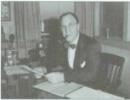Courtesy of the University of Wisconsin-Madison Archives
Charles Wedemeyer was born in Milwaukee, Wisconsin, in 1911 (Burton, 2010). In the 1930s Wedemeyer was a public school teacher and then principal of the Steuben Junior High School (Burton, 2010). During World War II, Wedemeyer created instructional techniques to benefit sailors who were operating in adverse learning conditions (Burton, 2010). “From this instrumental experience, Wedemeyer developed a theoretical framework for learning, using innovative communication technologies [that were] adapted for non-traditional learners” (Burton, 2010, p. 28).
The United States Army Institute pioneered computerized marking of assignments, 24-hour phone in counseling [Exhibit A], and use of tutorial groups[Exhibit B] (Moore & Kearsley, 2012). These were ideas which Wedemeyer adopted while in his position as the director of correspondence instruction at the University of Wisconsin (Moore & Kearsley, 2012).
The Articulated Instructional Media (AIM) project developed by Wedemeyer was the first test of the course team model to develop educational courses [Exhibit C] (Moore & Kearsley, 2012). Other innovations included counseling [Exhibit A], guidance [Exhibit D], and learning centers [Exhibit B] (Burton, 2010). This project attracted the interest of educational reformers in members of British Prime Minister Harold Wilson’s government (Burton, 2010). The planning committee visited Wisconsin in 1967 for further study of this project. Soon after, Wedemeyer was invited to London for further discussions (Moore & Kearsely, 2012). 1n 1969, Wedemeyer spent several months in the house of Walter Perry to assist in developing OU UK (Moore & Kearsely, 2012). “Almost the entire educational geography of an open educational system was identified in the AIM experiment” (Wedemeyer, 1982, p. 24).
So what relevance does Wedemeyer’s work have today in 2013 to a graduate student at UMUC? A graduate student, such as myself, has access a support systems 24 hours a day [Exhibit A]. I get to benefit from educational resources that are the effort of many different educators and specialists [Exhibit C]. I have a graduate advisor who helps guide me through the program [Exhibit D]. Now, I don’t have access to regional student centers but there are “250,000 students … supported by centres in the UK, Ireland and Europe” (http://www.open.ac.uk/about/main/) [Exhibit B].
Think for a minute about all the people who benefited from Wedemeyer’s influence as a public school teacher, as a principal, as a Naval instructor, at the University of Wisconsin, at all the OUs today! This blog just shares a few highlights of this amazing man’s contributions to education and education at a distance. Let me join all of them is saying Thank You, Charles Wedemeyer!
REFERENCES
Burton, G. (2010). Opening the great gate at “the palace of learning”: Charles A. Wedemeyer’s pioneering role as champion of the independent learner. Vitae Scholasticae, 27(1), 26-42. Retrieved from http://www.isebio.org/
Moore, M.G., & Kearsley, G. (2012). The historical context. In Distance education: A systems view of online learning (3rd ed., pp. 23-44). Belmont, CA: Wadsworth CengageLearning.
Wedemeyer, C. A. (1982). The birth of the Open University, a postscript. Teaching at a Distance, 21, pp. 21-27.
